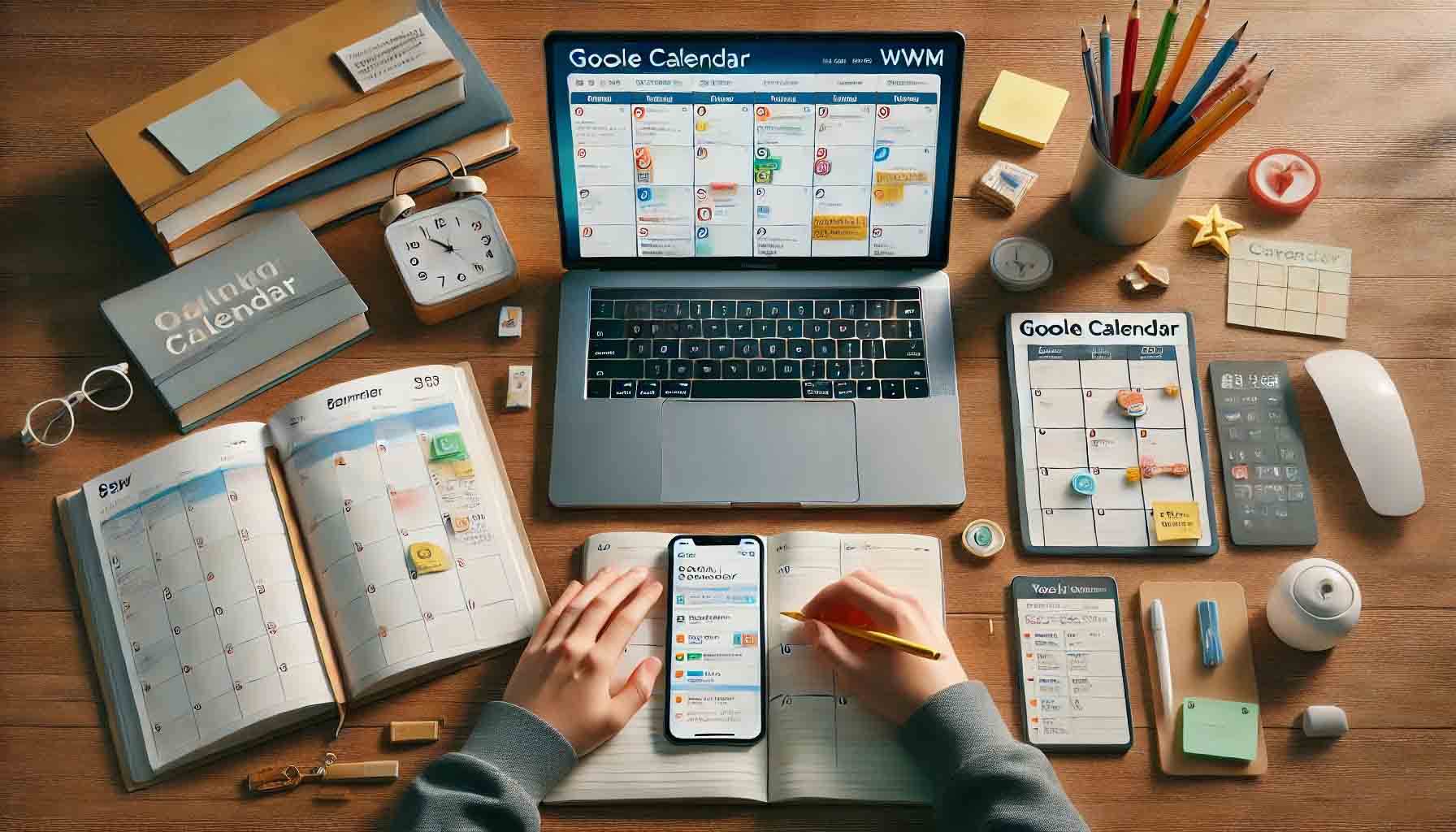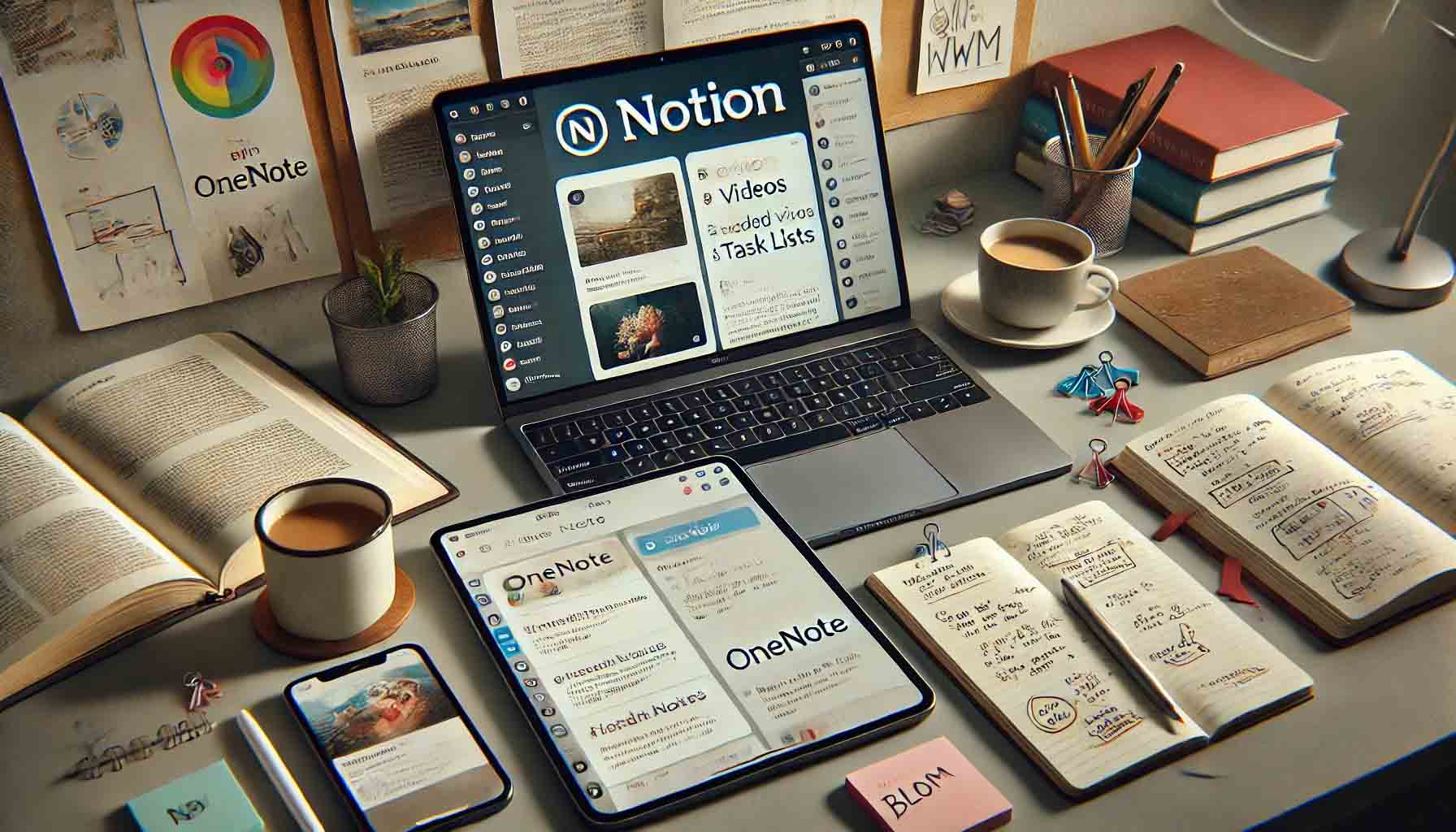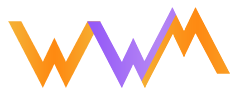
In today’s fast-paced academic environment, staying organized is more than just a helpful habit—it’s a critical skill for success. According to a recent survey by McGraw-Hill Education, over 74% of students reported that digital tools significantly improved their productivity and helped them manage their academic workload more effectively. This statistic underscores a broader trend: as education continues to evolve with the integration of technology, the need for effective digital organization tools has never been greater.
Why Staying Organized Matters More Than Ever
With the blend of in-person and digital learning environments, students are juggling more than ever—classes, assignments, extracurricular activities, and personal commitments. The traditional methods of organization, like paper planners and sticky notes, often fall short in keeping up with the dynamic and interconnected nature of today’s academic demands. Digital organization tools provide a more flexible and comprehensive solution, allowing students to synchronize their schedules, manage tasks, take detailed notes, and collaborate effortlessly—all from the convenience of their devices.
Moreover, staying organized is not just about managing time but also about reducing stress and improving mental well-being. A study by the American Psychological Association found that 75% of college students who use digital tools to manage their tasks reported feeling less overwhelmed by their workload. This highlights the broader impact of digital organization tools: they don’t just help students keep track of their responsibilities—they empower them to take control of their academic journey.
Purpose of the Article
In this article, we aim to provide a curated list of the best digital organization tools for students in 2024. From versatile calendar apps to powerful note-taking platforms, we will explore the features that make these tools indispensable for students striving to stay on top of their academic game. Additionally, we will highlight the marketing potential of these apps, offering insights into how brands can connect with this tech-savvy audience. Whether you’re a student looking to optimize your study habits or a marketer seeking to tap into the educational sector, this guide will provide valuable information and actionable strategies.

Why Digital Organization Tools are Essential for Students
Challenges Students Face
Today’s students face a unique set of challenges as they navigate the complexities of their academic and personal lives. Managing multiple assignments, adhering to strict deadlines, balancing extracurricular activities, and maintaining a social life can quickly become overwhelming. According to a survey by the Education Advisory Board, over 60% of students report feeling stressed about managing their time effectively, often leading to burnout and decreased academic performance. Additionally, the rise of hybrid and remote learning models has introduced new challenges, such as organizing digital coursework and keeping track of virtual meetings and deadlines.
These challenges are compounded by the sheer volume of information that students are expected to process daily. From lecture notes and homework assignments to project deadlines and social commitments, staying on top of everything without a robust organizational system can be daunting. Traditional methods, like paper planners or simple to-do lists, often fall short, leaving students searching for more effective ways to manage their academic responsibilities.
Benefits of Digital Tools
This is where digital organization tools come into play. Apps and platforms designed for productivity offer a multitude of benefits that traditional methods simply cannot match. These tools provide centralized hubs where students can manage all aspects of their academic lives—from scheduling and task management to note-taking and collaborative projects. For instance, tools like Notion and Microsoft To Do allow students to create comprehensive task lists, set deadlines, and prioritize their work, all while syncing seamlessly across multiple devices.
The benefits extend beyond mere task management. Digital tools also promote better time management by allowing students to visualize their schedules, set reminders, and break down large projects into manageable tasks. A study by the International Society for Technology in Education found that students who use digital tools for organization are 20% more likely to complete assignments on time and report a 15% increase in overall productivity. Moreover, these tools help reduce stress by providing students with a clear plan of action, thus alleviating the anxiety that often accompanies a disorganized workload.
Additionally, digital organization tools offer flexibility that traditional methods lack. Features like cloud storage and cross-platform accessibility mean students can access their information anytime, anywhere, whether they’re on campus, at home, or on the go. This level of accessibility is particularly beneficial in today’s hybrid learning environments, where students may need to switch between in-person and online classes at a moment’s notice.
Trend Analysis: The Rise of Digital Tools Among Gen Z
The growing reliance on digital organization tools is largely driven by Gen Z, a tech-savvy generation that has grown up with smartphones, social media, and instant access to information. A report by the Pew Research Center indicates that 95% of teens have access to a smartphone, and 45% say they are online “almost constantly.” This digital fluency naturally extends to their approach to education, where they gravitate towards solutions that integrate technology into their learning process.
In fact, the use of digital organization tools among students is not just a trend but a reflection of a broader shift towards digital-first solutions in education. Apps like Google Calendar, Trello, and Evernote have become staples for students looking to streamline their workflows and optimize their study habits. The trend is expected to continue growing, with the global EdTech market projected to reach $404 billion by 2025, according to HolonIQ.
This trend also presents significant opportunities for brands and app developers looking to tap into the educational sector. By offering student-friendly features, discounts, or integrations that cater specifically to academic needs, companies can position themselves as essential tools in a student’s digital toolkit.

Top Digital Organization Tools for Students in 2024
1. Calendar and Scheduling Apps
Google Calendar
Google Calendar remains one of the most popular digital organization tools among students, thanks to its seamless integration with other Google services like Gmail, Google Drive, and Google Classroom. It offers a suite of features that cater specifically to the needs of busy students: shareable calendars for group projects, color-coded events for easy categorization, and reminders that help keep important deadlines and commitments at the forefront.
One of the standout features of Google Calendar is its ability to sync across multiple devices, ensuring that students always have access to their schedules whether they’re on a laptop, tablet, or smartphone. This cross-platform accessibility is a key advantage in today’s learning environment, where flexibility and mobility are essential. Additionally, Google Calendar’s integration with tasks and reminders allows students to not only schedule their classes and assignments but also break down their workload into manageable tasks that are easy to track.
Benefits: Google Calendar’s intuitive interface and powerful integration capabilities make it a go-to tool for students looking to manage their time efficiently. It helps students maintain a clear overview of their commitments, reducing the likelihood of missed deadlines or overlapping schedules. The ability to set recurring events is particularly beneficial for students with weekly classes or ongoing commitments, as it automates much of the scheduling process.
Marketing Potential: Brands have significant opportunities to leverage Google Calendar’s features to engage with the student market. Educational institutions and EdTech companies can create custom integrations or plugins that enhance Google Calendar’s functionality, such as course-specific calendars or exam countdowns. Additionally, businesses can explore sponsorship opportunities for school events or reminders within the app, subtly integrating their presence into students’ daily routines.
Notion Calendar
Notion has rapidly gained popularity as a versatile tool that combines the functionality of a calendar, task manager, note-taker, and database into a single platform. Its calendar feature, in particular, offers extensive customization options, allowing students to tailor their scheduling needs to their personal preferences. Unlike traditional calendar apps, Notion Calendar enables users to integrate tasks, notes, and even project timelines directly into their schedules, creating a more holistic view of their academic responsibilities.
One of the key benefits of Notion Calendar is its flexibility. Students can create multiple calendar views—such as weekly, monthly, or even project-specific calendars—that are linked to broader databases of tasks and notes. This interconnected system is ideal for students managing complex coursework or group projects, as it allows them to organize information in a way that is both visual and highly detailed.
Benefits: Notion Calendar’s ability to integrate with other Notion features makes it an excellent tool for comprehensive project management. Students can embed class notes, attach relevant files, and tag collaborators directly within their calendar events, making it easier to keep all related information in one place. This level of integration can save time and reduce the cognitive load of switching between multiple apps.
Marketing Potential: Educational brands and content creators have unique opportunities to connect with students through Notion. By offering pre-made Notion templates tailored for specific academic needs—such as study schedules, assignment trackers, or project planners—brands can position themselves as valuable resources in a student’s academic journey. Additionally, Notion’s growing community of users provides a platform for brands to engage directly with students through tutorials, webinars, or collaborative projects.

Task Management and To-Do List Apps
Todoist
Todoist is a versatile and powerful task management app that has become a favorite among students for its ability to simplify complex workloads into manageable tasks. The app offers a range of features that cater to the needs of students, including task prioritization, deadline setting, recurring tasks, and progress tracking. These features allow students to break down their assignments and study plans into smaller, actionable steps, making it easier to stay organized and meet deadlines.
One of the standout aspects of Todoist is its clean and user-friendly interface, which makes it easy for students to navigate their tasks and focus on what needs to be done. The app’s prioritization feature allows users to mark tasks as high, medium, or low priority, helping students allocate their time effectively based on urgency and importance. Additionally, Todoist’s recurring task option is particularly useful for students with regular commitments, such as weekly readings or ongoing study sessions, as it automatically sets up tasks to repeat at specified intervals.
Benefits: Todoist’s progress tracking and productivity visualizations, such as task completion streaks and charts, provide students with a clear sense of accomplishment and motivation. This gamified approach not only makes task management more engaging but also helps students build productive habits over time. By visualizing their progress, students can stay motivated and adjust their strategies as needed to optimize their workflow.
Marketing Potential: For brands, Todoist offers substantial marketing potential, particularly through its business plans and educational features. Companies targeting the student market can leverage Todoist’s integration capabilities with other popular tools, such as Google Calendar and Slack, to create comprehensive productivity solutions tailored for students. Educational institutions can also explore partnerships with Todoist to provide premium access or customized templates that support academic success, positioning Todoist as a key component of a student’s organizational toolkit.
Microsoft To Do
Microsoft To Do is another robust task management app that seamlessly integrates with the Microsoft Office suite, making it a natural choice for students who are already using tools like Word, Excel, and OneNote. Microsoft To Do offers features such as daily planners, list sharing, and task categorization, all within a simple, intuitive interface. One of the key strengths of Microsoft To Do is its deep integration with other Microsoft products, allowing students to effortlessly sync tasks from Outlook or collaborate on shared lists with classmates through Teams.
With Microsoft To Do, students can create detailed daily plans that not only outline their academic tasks but also include personal commitments, providing a holistic view of their day. The app’s My Day feature encourages users to plan their day each morning by suggesting tasks from their overall list, helping students focus on what matters most. List sharing is another valuable feature, enabling students to collaborate on group assignments or projects by sharing task lists with peers and tracking progress collectively.
Benefits: Microsoft To Do’s integration with the broader Microsoft ecosystem offers students a seamless experience, reducing the friction of moving between different platforms. This interconnectedness is particularly beneficial in academic settings, where students often use multiple Microsoft applications for various aspects of their coursework. By consolidating tasks, reminders, and collaboration in one place, Microsoft To Do helps students streamline their workflow and stay on top of their responsibilities.
Marketing Potential: Microsoft has the opportunity to promote bundled educational solutions that include Microsoft To Do as part of a comprehensive student package. By highlighting the integration of To Do with other educational tools like OneNote and Teams, Microsoft can position its suite as the ultimate productivity solution for students. Additionally, offering special student pricing or exclusive features can further enhance Microsoft To Do’s appeal in the competitive market of task management apps.

Note-Taking Apps
Notion
Notion has rapidly established itself as a powerhouse in the realm of note-taking and digital organization, offering a wide range of features that extend far beyond simple text notes. Its versatility allows students to create comprehensive, multimedia-rich notes by embedding videos, links, databases, and task lists directly into their workspace. This flexibility makes Notion particularly valuable for managing complex projects or studying for subjects that require a variety of resources, such as articles, videos, and interactive content.
One of the standout features of Notion is its ability to create interconnected pages and databases, which allows students to build a personalized, modular system tailored to their needs. Whether it’s organizing lecture notes, creating a study schedule, or managing a group project, Notion provides the tools to keep everything neatly structured and easily accessible. Additionally, the app’s collaborative features enable students to share pages and work together in real-time, making it an excellent choice for group assignments or study groups.
Benefits: Notion’s comprehensive approach to note-taking and organization helps students streamline their academic lives by centralizing all their information in one place. This not only saves time but also reduces the cognitive load of juggling multiple apps and platforms. The ability to embed various types of media means students can keep all their study materials, from video tutorials to interactive quizzes, within the same ecosystem, enhancing the learning experience.
Marketing Potential: Notion’s robust collaboration features present significant marketing opportunities, particularly for educational brands and institutions. By developing custom templates for specific courses or study needs, brands can tap into Notion’s user base and position themselves as valuable resources for students. Additionally, offering student discounts or premium features can further enhance Notion’s appeal in the competitive note-taking app market, driving both engagement and brand loyalty.
OneNote
Microsoft OneNote remains a staple in the world of digital note-taking, especially for students who are deeply embedded in the Microsoft ecosystem. OneNote functions as a digital notebook that supports a wide array of note-taking styles, from typed text and bullet points to handwritten notes and drawings, thanks to its handwriting support. This versatility allows students to take notes in the way that best suits their learning style, whether they’re typing during a lecture or sketching diagrams for a complex concept.
One of the key features of OneNote is its seamless integration with other Microsoft Office apps, such as Word, Excel, and PowerPoint, as well as its robust cloud syncing capabilities through OneDrive. This ensures that students can access their notes from any device, at any time, making it easier to study on the go or switch between different learning environments. Additionally, OneNote’s multimedia integration allows students to insert images, audio recordings, and even web clippings directly into their notes, creating rich, interactive study guides.
Benefits: OneNote’s ability to organize notes into notebooks, sections, and pages provides a clear, hierarchical structure that helps students keep their notes tidy and easy to navigate. The app’s collaboration features also enable students to share notebooks and work on group projects, making it a versatile tool for both individual study and team efforts. Moreover, OneNote’s support for handwriting and drawing is particularly beneficial for students in subjects that involve equations, diagrams, or other visual elements.
Marketing Potential: Microsoft’s strong presence in educational institutions offers a significant advantage when promoting OneNote. By bundling OneNote with other Microsoft tools in educational packages, Microsoft can provide a comprehensive suite of solutions tailored for students. Additionally, highlighting OneNote’s unique features, such as handwriting support and multimedia integration, can help differentiate it from other note-taking apps in the market. Offering targeted promotions, such as free access for students or special educational discounts, can further solidify OneNote’s position as a go-to tool for digital note-taking.

Study and Focus Apps
Forest
Forest is an innovative app that combines productivity with gamification, making the often daunting task of staying focused both engaging and rewarding. The core concept of Forest revolves around growing a virtual tree during each focused study session. As long as the user remains on task and refrains from using their phone for distractions, the tree continues to grow. Conversely, if the user exits the app to check social media or browse the web, the tree withers and dies. This unique approach not only helps students maintain their focus but also provides a visual representation of their productivity efforts.
Forest’s appeal extends beyond its clever gamification. It also integrates environmental awareness into its platform by allowing users to spend their earned virtual coins to plant real trees through Forest’s partnership with Trees for the Future. To date, Forest users have collectively planted over 1.5 million trees worldwide, blending personal productivity with a broader environmental impact.
Benefits: Forest effectively addresses one of the most common challenges faced by students today: distraction from smartphones. By turning the act of staying focused into a game, Forest taps into the competitive and achievement-oriented mindset of students, encouraging them to stay on task. The visual representation of growth, along with the tangible reward of planting real trees, adds a sense of purpose and fulfillment to the study process, making it easier for students to develop healthy study habits.
Marketing Potential: Forest’s unique combination of gamification and environmental impact opens up numerous marketing opportunities. Brands can partner with Forest for gamified sponsorships or educational campaigns that promote focus and productivity. For instance, a brand could sponsor a challenge where students compete to grow the most trees in a week, with rewards or discounts offered to top performers. Such collaborations not only enhance brand visibility but also align with values of sustainability and social responsibility, which resonate strongly with younger audiences.
Focus Booster
Focus Booster is another popular app designed to help students maximize their productivity using the Pomodoro technique—a time management method that involves working in focused intervals (usually 25 minutes) followed by short breaks. Focus Booster provides an intuitive interface that tracks these work sessions, automatically timing breaks and offering session reports that help users analyze their productivity patterns.
The app’s simplicity and effectiveness make it a go-to tool for students looking to improve their time management skills. Focus Booster’s ability to track and analyze study sessions allows students to gain insights into their most productive times of day, identify distractions, and refine their study habits accordingly. The app’s reporting feature provides a detailed breakdown of time spent on various tasks, which can be particularly beneficial for students managing multiple projects or preparing for exams.
Benefits: Focus Booster’s Pomodoro-based approach helps students maintain concentration and avoid burnout by encouraging regular breaks. This method has been shown to enhance cognitive function and overall productivity, making it easier for students to tackle large amounts of study material without feeling overwhelmed. The app’s detailed reports also offer valuable data that students can use to optimize their study schedules and set realistic goals.
Marketing Potential: Focus Booster offers numerous opportunities for brands interested in promoting productivity tools. The app’s user base of students and professionals makes it an ideal platform for sponsorships, particularly for brands that align with themes of efficiency and personal development. Content marketing campaigns, such as blogs or webinars on effective study techniques, can be integrated with Focus Booster’s platform to engage users and provide added value. Additionally, brands can explore offering exclusive content or extended features through Focus Booster as part of a promotional partnership, further enhancing the app’s appeal to its target audience.

File and Document Management Apps
Google Drive
Google Drive has long been a staple in the realm of file and document management, particularly for students who need a reliable and accessible way to store, share, and collaborate on their academic work. With features such as cloud storage, real-time document collaboration, and easy sharing options, Google Drive provides a comprehensive solution for managing digital files. Its seamless integration with other Google services, like Google Docs, Sheets, and Slides, allows students to create, edit, and store documents directly within the platform, making it an indispensable tool for both individual and group projects.
One of the key strengths of Google Drive is its collaborative capabilities. Students can easily share files with peers, set permissions, and work simultaneously on documents, which is especially beneficial for group assignments or study sessions. The ability to leave comments, suggest edits, and track changes in real-time enhances the collaborative experience, ensuring that everyone stays on the same page without the hassle of version control issues.
Benefits: Google Drive centralizes all of a student’s documents in one secure location, accessible from any device with internet connectivity. This not only simplifies file management but also provides peace of mind with automatic saving and robust security features. The app’s integration with Google Classroom further streamlines the workflow for students, allowing them to submit assignments, receive feedback, and access class materials all within the same ecosystem. With 15 GB of free storage and affordable options for additional space, Google Drive caters to a wide range of storage needs, from storing lecture notes to backing up large multimedia projects.
Marketing Potential: Google Drive’s extensive reach and integration with educational platforms present significant opportunities for partnerships with schools, colleges, and universities. By offering extended storage or premium features as part of educational packages, Google can further embed its services into the academic experience. Additionally, Google’s ability to provide analytics and usage insights offers a unique avenue for educational institutions to monitor student engagement and resource utilization, making it a valuable partner in digital learning initiatives.
Dropbox
Dropbox is another formidable player in the file management space, known for its intuitive design and reliable performance. Dropbox offers cloud storage, document scanning, and seamless syncing across devices, ensuring that students have easy access to their files no matter where they are. With features like automatic backups, offline access, and advanced file-sharing options, Dropbox provides a robust solution for students who need a versatile and dependable platform for managing their digital assets.
One of Dropbox’s standout features is its Smart Sync, which allows students to access their entire Dropbox library without taking up local storage on their devices. This is particularly beneficial for students with limited storage capacity on their laptops or mobile devices. Additionally, Dropbox’s document scanning feature turns the app into a portable scanner, enabling students to digitize handouts, notes, and other physical documents, thus reducing clutter and improving organization.
Benefits: Dropbox’s strong emphasis on security and data protection makes it a trusted choice for students concerned about the safety of their files. With features like two-factor authentication, encrypted data transfers, and remote device wipe capabilities, Dropbox ensures that student data remains secure. The app’s intuitive interface and drag-and-drop functionality make it easy to organize files into folders and subfolders, supporting a structured approach to file management that can be tailored to individual study needs.
Marketing Potential: Dropbox’s positioning as a premium service provides opportunities to leverage student pricing and promotions, especially during back-to-school seasons when demand for organizational tools spikes. By partnering with educational institutions, Dropbox can offer tailored solutions, such as increased storage or bundled services, that specifically address the needs of students. Additionally, Dropbox’s focus on collaboration tools, like Dropbox Paper, opens up avenues for marketing campaigns centered around teamwork and productivity, appealing directly to the academic community.

How Brands Can Leverage These Tools for Marketing
Student Discounts and Offers
In today’s competitive market, brands looking to capture the attention of students can greatly benefit from offering special pricing or bundles on digital organization tools. Students are often budget-conscious, and providing exclusive discounts can be a decisive factor in their purchasing decisions. For example, companies like Adobe and Spotify have successfully employed student discount strategies, leading to increased adoption among the student demographic.
Offering student discounts not only boosts sales but also helps build brand loyalty at an early stage. A 2023 survey by Student Beans found that 80% of students are more likely to choose a brand if it offers a student discount, and 60% are likely to continue using that brand after graduation if they receive a good student deal. This presents a unique opportunity for brands to create long-term customer relationships by establishing their products as essential tools during formative academic years.
Beyond simple discounts, brands can also explore bundling their tools with other complementary services or products that cater to the needs of students. For instance, a note-taking app could be bundled with a task management tool, providing a comprehensive solution that addresses multiple aspects of a student’s academic life. Such bundles not only add value but also enhance the overall user experience, making them an attractive proposition for students seeking efficiency and convenience.
Partnerships with Educational Institutions
Partnering with schools, colleges, and universities offers brands a direct pathway into the academic environment, allowing them to integrate their digital tools into the curriculum. These partnerships can take various forms, from providing schools with free or discounted access to software, to developing custom solutions tailored to the specific needs of educational institutions.
One notable example of successful educational partnerships is Google’s collaboration with schools through Google Workspace for Education. By offering a suite of free productivity tools to educational institutions, Google has entrenched itself as a key player in the academic space, providing students and educators with easy-to-use, collaborative tools that enhance the learning experience. Similarly, brands can explore opportunities to embed their digital organization tools into classroom activities, homework assignments, or administrative tasks, thereby gaining visibility and encouraging adoption among students.
Brands can also offer training sessions, workshops, or webinars to help educators and students maximize the benefits of their tools. By demonstrating how these digital organization apps can improve productivity and academic performance, brands can build trust and credibility within the educational community, further strengthening their market position.
Content Marketing Opportunities
Content marketing presents a powerful way for brands to engage with students and showcase the practical benefits of their digital organization tools. By creating educational content, such as blogs, video tutorials, webinars, or interactive guides, brands can provide valuable insights that help students make the most of their products. This approach not only drives engagement but also positions the brand as an expert resource in the field of academic productivity.
For instance, a task management app could produce a series of blog posts on effective time management strategies, incorporating case studies or testimonials from students who have successfully used the app to improve their study routines. Similarly, a note-taking platform might offer video tutorials on organizing digital notes for different subjects, highlighting the app’s features in a practical, user-centric way.
Brands can also capitalize on seasonal content marketing opportunities, such as back-to-school campaigns or exam preparation guides. By aligning their content with the academic calendar, brands can stay relevant and provide timely support to students during critical periods of the school year. Additionally, engaging students through social media channels, influencer partnerships, or user-generated content campaigns can further amplify the reach and impact of their content marketing efforts.

Future Trends in Digital Organization Tools for Students
AI and Personalization
As technology continues to evolve, artificial intelligence (AI) is set to play an increasingly significant role in digital organization tools for students. AI-powered features can elevate these tools by providing personalized suggestions and adaptive learning experiences that cater to individual student needs. For example, AI can analyze a student’s study habits, assignment deadlines, and class schedules to offer tailored recommendations on the best times to study, when to take breaks, and even which subjects to prioritize. This level of personalization helps students optimize their time and enhances their overall learning experience.
Adaptive learning, another facet of AI, can further customize the student experience by adjusting content and difficulty based on a student’s performance and progress. For instance, a digital organizer might suggest specific study methods or resources for a subject that a student struggles with, helping them to grasp challenging concepts more effectively. As AI algorithms become more sophisticated, the potential for hyper-personalized educational experiences will grow, making digital organization tools not just a convenience but a critical component of a student’s academic success.
Integration Across Platforms
In the digital age, students often juggle multiple apps and platforms for various academic tasks—from note-taking and task management to communication and collaboration. The future of digital organization tools lies in seamless integration across these platforms, creating a cohesive and unified user experience. Tools that can effortlessly sync data, share information, and integrate functionalities will stand out in a crowded market.
For instance, imagine a scenario where a task noted in a project management app automatically appears in a student’s calendar, and relevant documents are linked from cloud storage without any manual input. Such seamless integration not only saves time but also reduces the cognitive load on students, allowing them to focus more on learning rather than managing their tools. This trend towards interoperability will drive the development of more connected and versatile digital ecosystems, where data flows effortlessly between applications, creating a streamlined and efficient workflow for students.
Growing Emphasis on Mental Health
Beyond productivity, future digital organization tools are likely to place a stronger emphasis on mental health and well-being. The pressures of academic life can often lead to stress and burnout, and students increasingly seek tools that support not just their academic performance but also their mental health. Features such as wellness reminders, guided breaks, and integrated mindfulness exercises can help students maintain a balanced approach to their studies.
Some emerging apps are already incorporating these elements, offering features like mood tracking, relaxation exercises, or even alerts to step away from screens after prolonged periods. This shift towards holistic support reflects a broader trend in education that recognizes the importance of mental health in achieving academic success. As awareness grows, the demand for tools that cater to both productivity and well-being is expected to rise, driving innovation in this space.
For example, future digital organizers might use AI to detect signs of stress based on a student’s interaction patterns—such as frequent task switching or late-night study sessions—and suggest relaxation techniques or encourage breaks. By integrating mental health support into digital organization tools, developers can create solutions that address the complete needs of students, fostering both academic achievement and personal well-being.

Conclusion
As students navigate the complexities of academic life in 2024, digital organization tools have become invaluable allies in their journey. From Google Calendar’s seamless scheduling features to Notion’s versatile note-taking capabilities, these apps provide essential support in managing tasks, deadlines, and collaboration. Tools like Todoist and Microsoft To Do offer intuitive task management solutions that help students break down assignments into manageable steps, while focus apps such as Forest and Focus Booster keep distractions at bay and enhance productivity. File management platforms like Google Drive and Dropbox ensure that students’ documents are always accessible and organized, streamlining both individual and group work.
The benefits of these tools are clear: increased productivity, better time management, reduced stress, and enhanced collaboration. By integrating these apps into their daily routines, students can not only stay on top of their academic responsibilities but also achieve a healthier balance between schoolwork and personal life.
If you’re looking to streamline your academic life and boost your productivity, now is the perfect time to explore these digital organization tools. Whether you’re aiming to better manage your schedule, keep your notes organized, or stay focused during study sessions, there’s an app tailored to meet your needs. Try out these tools and see how they can transform your study habits and help you achieve your academic goals.
We’d love to hear from you! What are your favorite organization tools, and how do they help you stay productive? Share your experiences in the comments below—your insights could help fellow students discover new ways to enhance their study routines.

